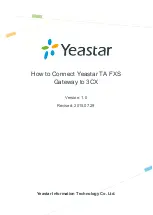
Page 77 / 141
DTUS065 rev A.7 – June 27, 2014
Minimum roaming interval:
If you want to avoid continual roaming when all the APs have about the
same low signal level (below the leave level), you can enforce a minimum
delay between two successive roaming processes.
No-return delay:
In areas with many walls, an AP that was left because it became too far
away, may appear very good for a short time, due to radio waves bounces.
To avoid roaming back to this kind of APs, which you know are far, you can
add a delay here.
Threshold hysteresis:
In order to avoid oscillating behaviors when the measured received signal is
unstable (which is usually the case), the scan, leave and excessive thresholds
are, in fact, interpreted as intervals of width ± hysteresis centered on the
threshold.
RSSI smoothing factor:
Thresholds are compared to the average power of the beacons received from
the current AP. The smoothing factor adjusts the pace at which old beacons
are forgotten in the moving average calculation.
Beacon timeout:
The number of consecutive missing beacons from the current AP, that will
cause disassociation and search for a new AP. The corresponding duration
depends on the beacon interval set in the AP.
Maximum time off-channel:
When scanning another channel, the current AP is told to buffer incoming
data until the client returns to the channel of the AP. Some APs have
insufficient buffers and loose data in the meantime. This parameter limits the
duration where the scanner is scanning on other channels, so the it returns to
the AP channel before the AP buffers are exhausted. This duration must be
set greater than the sum of the two next parameters. It will be further
reduced automatically to the duration of the AP beacon interval. Its precision
is about 10 ms.
If this parameter is large enough, the scanner can switch channels and send
probes several times before returning to the current AP channel.
Off-channel probe request delay:
When switching to another channel, the radio must listen silently to
synchronize with existing devices already using the new channel. The probe
request is sent after this delay elapses after the channel switch.
Per channel probe response delay:
The time the scanner will stay on the scanned channel after sending a probe
request, waiting for probe responses or beacons. To tune this parameter, you
must account for the traffic on the channel and the swiftness of the AP (or its
controller) at answering probe requests.
















































